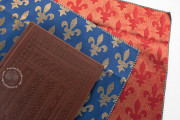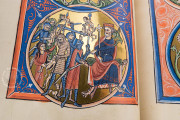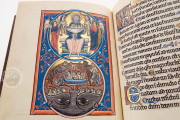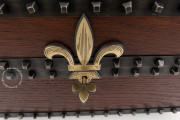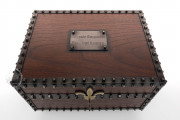The Psalter of Blanche of Castile represents the height of French Gothic illumination. Made in Paris in the early thirteenth century, it is a manuscript of the biblical book of Psalms supplemented by other texts and intended to aid in Christian devotions. Wrapped in an embroidered chemise (textile cover), the manuscript opens with a full-page frontispiece, a liturgical calendar, and an extensive cycle of full-page miniatures. No expense was spared, and the book features twenty-six miniatures and ten historiated initials of vibrant colors and gold.
The manuscript's main text is the 150 psalms, along with canticles, further prayers, and a litany in Latin. There are titles and rubrics in gold and blue, elaborate illuminated initials at the beginning of each psalm, alternating blue and gold initials for each verse, and a delightful variety of geometric, floral, and zoomorphic line fillers of blue and gold.
Science at the Forefront
The frontispiece of the psalter depicts three tonsured astronomers observing the sky (fol. 1v). The miniature is a significant medieval depiction of an astrolabe, a device capable of working out several kinds of problems in astronomy. The focus on the observation of the heavens and the movement of time ties in well with the following calendar's mapping of the year.
An Extensive Miniature Cycle
The series of miniatures that follows the calendar includes Old Testament scenes and images from the life of Christ and the Virgin, extending from the Fall of the Rebel Angels to the Dormition and Coronation of the Virgin (fols. 9v-29v). Most of these miniatures are formed of two interlocking medallions set on a decorative rectangular field and feature unusual subjects.
Made for Blanche of Castile?
The book owes its nickname to Blanche of Castile (1188-1252), consort of Louis VIII, King of France, and mother of Louis IX. One reason for thinking the manuscript was made for her is a notice added to the calendar that commemorates the death of her father, Alphonso VIII, King of Castile. An inscription from the fourteenth century mentions that the book belonged to Louis IX, King of France, but was made for his mother (fol. 190v), also suggesting a connection to Blanche. There is, however, some scholarly debate as to whether she was the intended recipient.
Probably Intended for a Female Reader
One of the prayers uses feminine Latin endings to refer to the supplicant (fol. 190r), so the book does seem to have been commissioned for a woman. The historiated initial introducing Psalm 101 depicts a woman kneeling before an altar, a book at her knees (fol. 122v). The figure is uncrowned, perhaps a depiction of Blanche before she ascended the throne in 1223.
A Gold-Embroidered Chemise
From about 1335 until the end of the eighteenth century, the psalter was kept in the treasury of the French royal chapel, the Sainte-Chapelle. The psalter's ties to Louis IX were commemorated in the fourteenth century when a gold-embroidered chemise was made to wrap and protect what came to be considered a relic of the saintly king. This lavish embroidery features a fleur-de-lys pattern embroidered in gold on a regal blue background.
The manuscript was confiscated at the time of the French Revolution and entered the Bibliothèque de l'Arsenal in 1798. It spent a brief time (1852-1872) on deposit at the Musée des Souvrains.
We have 3 facsimiles of the manuscript "Psalter of Blanche of Castile":
- Der Königs Psalter der Sainte Chapelle (Library Edition with Chemise) facsimile edition published by Mueller & Schindler, 2021
- Der Königs Psalter der Sainte Chapelle (Library Edition) facsimile edition published by Mueller & Schindler, 2021
- Der Königs Psalter der Sainte Chapelle facsimile edition published by Mueller & Schindler, 2021






